French Carriage Clock
Below are photos of a French carriage clock (circa 1880 - 1890) as it was disassembled. French carriage clocks differed from French pendulum clocks in that they were designed to be portable. They could be moved without affecting the timekeeping. The case made it possible to view the mechanism from all sides, making them especially attractive.
This carriage clock has a repeater strike mechanism. It has a button on top of the case which can be pressed to hear the strike. This feature made it possible to tell time in the dark. The clock also has an alarum (alarm mechanism). The result is a complicated arrangement of gears and levers. All parts were fitted and finished by hand.
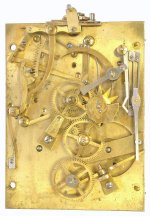
|
Fig. 1
The rear view in Figure 2 shows the alarm hammer on the left and the hour strike hammer on the right.
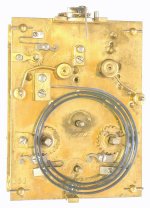
|
Fig. 2
The side view in Figure 3 shows the gears of the strike mechanism.
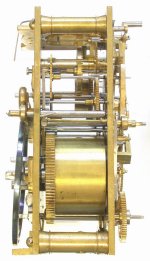
|
Fig. 3
The side view of Figure 4 shows the alarm mechanism. The mainspring barrel for the alarm is smaller than the others.
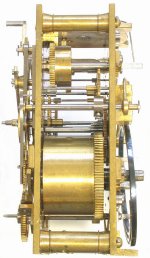
|
Fig. 4
In Figure 5, the alarm mechanism is in front. The time train is in the middle and the strike train is in the rear. The craftsmanship is superb.
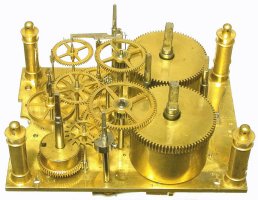
|
Fig. 5
French carriage clocks were equipped with platform escapements, usually cylinder escapements, English Lever or Swiss Lever escapements. This platform has an English Lever escapement. The top surface was silver plated.

|
Fig. 6
A better view of the English Lever escapement can be seen after some parts are removed.

|
Fig. 7
The balance wheel has a single roller, typical for English Levers.

|
Fig. 8
Anyone intested in escapement theory will enjoy the following photos of an English Lever with a replacement Swiss-type club-tooth escape wheel. It works very well and is actually an improvement because the teeth are much stronger.

|
Fig. 9
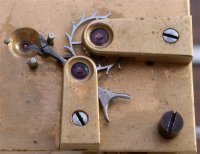
|
Fig. 10
Compare Figure 1 with Figure 11, which shows the front plate of another carriage clock with a non-repeater strike mechanism and no alarm. This layout is similar to many other French clocks. Notice the stopworks on the time barrel.

|
Fig. 11
There is nothing unusual about the design of this clock that the watchmaker needs to watch out for. The design of the strike rack mechanism is the best I have seen (read the essay about repairing the strike rack mechanism, in this website). However, the post for the gathering pallet is small and easily broken off. Look for wear in the escapement: the balance may need to be restaffed. Check the depthing of the contrate gear into the escape wheel pinion carefully.
French carriage clocks should only be serviced by experienced watchmakers since many clockmakers do not have the skills needed to service a clock that is actually more like a watch than a clock. They are among the most difficult clocks to service.
It is difficult to appreciate quality until you have something to compare it to. Figures 12 and 13 show a modern Chinese (?) carriage clock (circa 2001). Despite its numerous features (hour repeater, alarm, day, date), the craftsmanship is no comparison next to a French carriage clock.
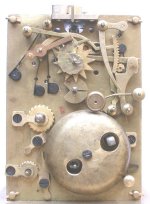
|
Fig. 12
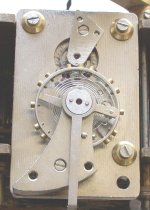
|
Fig. 13
Here is another interesting platform from a Kieninger mantle clock mechanism (ca. 2002).
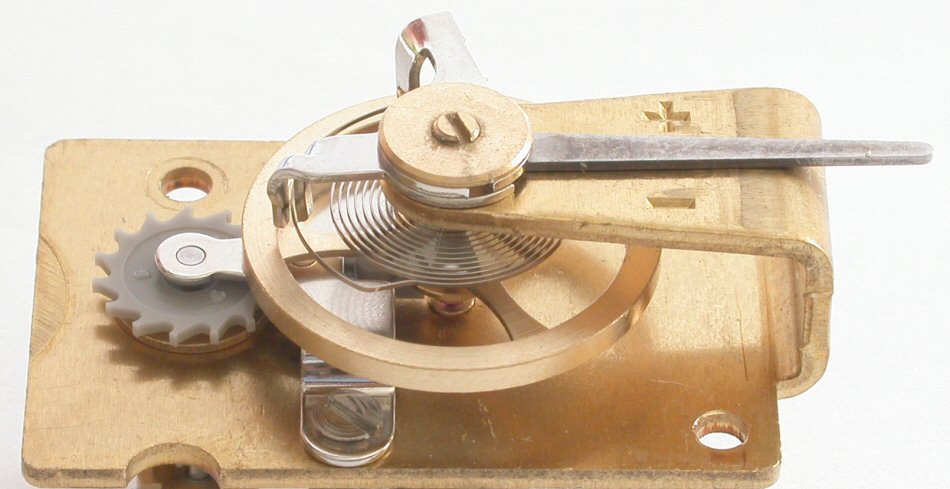
|
Fig. 14
Figure 15 shows a platform from a Hermle ship's bell clock mechanism (ca. 2007). Virtually all of the new ship's bells clocks, except for Chelsea clocks, have this mechanism. It appears to have the same plastic escape wheel as the Kieninger platform above, and both platforms have the same problem. When the clocks are in the vertical position, sitting on the table or hanging on the wall, the oscillation of the balance wheel is reduced considerably and the clocks stop at apparently random intervals. However, when the clocks are positioned in the face-up or face-down positions, they work well. My conclusion is that the plastic pallets do not have enough draw designed into them. Lack of draw allows the safety pin on the pallet fork to rub on the roller table, causing the reliability problem.
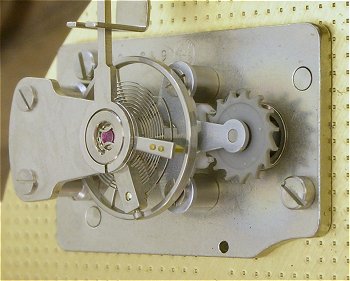
|
Fig. 15
Below are some photos of another French carriage clock, ca. 1890. This one has an hour-strike repeater mechanism. The gold plating is very clean and undamaged. The dial and side panels have enamel paintings. It is stunning.
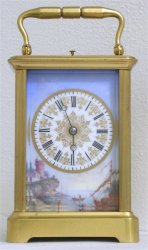
|
Fig. 16

|
Fig. 17

|
Fig. 18

|
Fig. 19
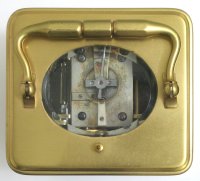
|
Fig. 20
|
|
Go to French Morbier Clock
Clock Repair Main Page
Escapements in Motion
Links Page